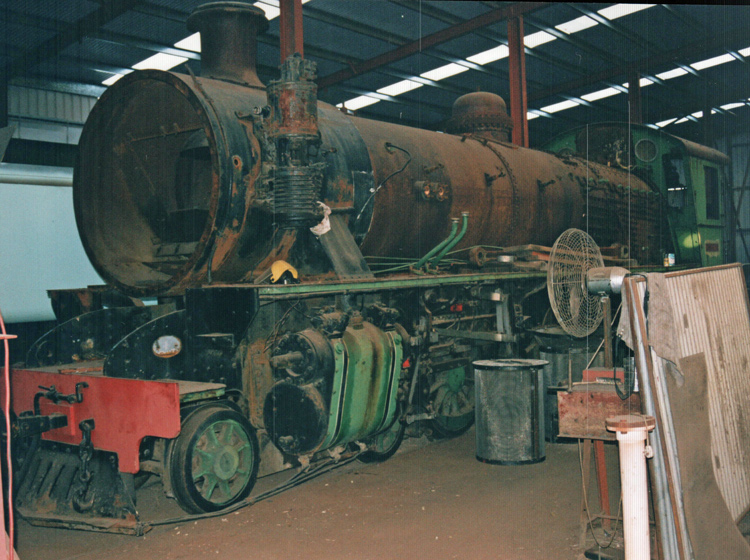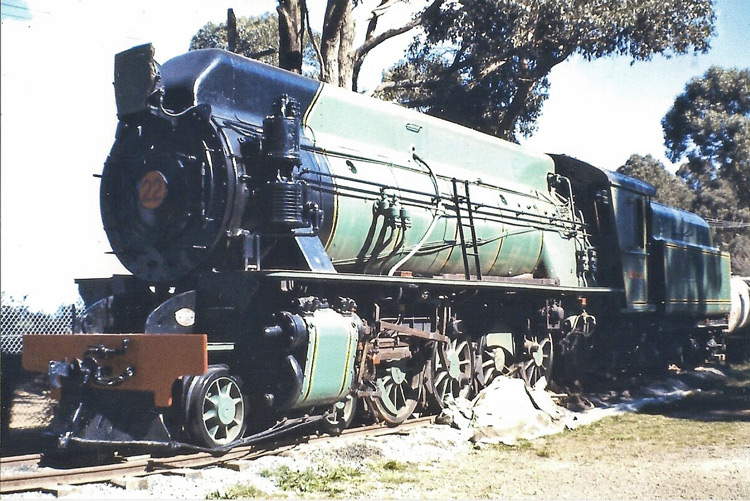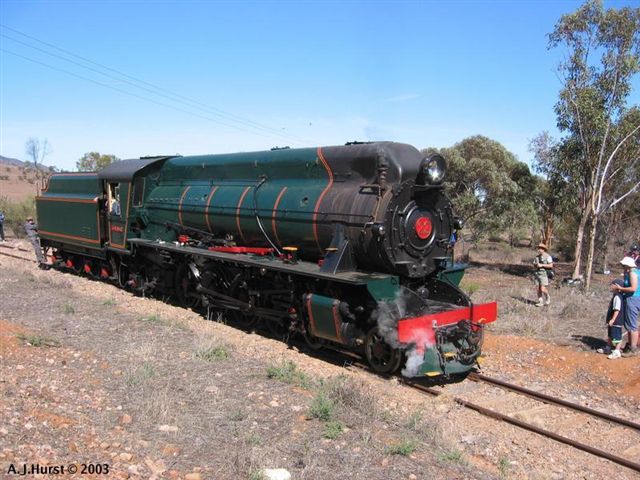
|
Silverton Tramway Co. W 22 Named "Justin Hancock" |

The real W 22 is seen in this 11 June 2000 photograph stored in the Pichi Richi Railway workshops at Quorn.
It has been
stripped of its cowling and boiler clothing, and significant rusting is evident on the boiler barrel.Comparison with the slide views below shows the faded livery and former position of the "Justin Hancock" nameplate on the cabside.
This locomotive was built by Beyer Peacock & Co (builder's number 7418 of 1951) as the first of four Silverton Tramway's W-class engines. These locomotives built to the West Australian Government Railway's W-class 4-8-2 design but with minor differences, the most visible being the decorative cowling along the boiler top which originated from the original WAGR specification by the Chief Mechanical Engineer, Frederick Mills. This distinctive boiler cowling also featured on his S-class 4-8-2 and ASG Garratt designs. Adrian Gunzberg's fine book "A history of WAGR Steam Locomotives" gives an excellent account of how the WAGR W-class design evolved from the original Mills design to the final Beyer-Peacock design following Mill's death in 1949; the survival of the Mills boiler cowling on the four Silverton locomotives is an interesting quirk of history. The builder's number sequence for the 4 Silverton locomotives (7418/9, 7553/54) suggests they were built concurrently with WAGR W-class, the first two being sequenced after the initial order for 40 units (b/n 7378-7417) but before the WAGR order for a further 20 units (b/n 7453-7472), and the final two after the second WAGR batch.
An interesting feature of the design was the sloping cab front which was parallel with the boiler / firebox back plate; this minimised the area of boiler that was within the cab. Anyone who has been in the cab of a steam locomotive during the heat of the Australian summer would appreciate this feature!
W 22 was named 'Justin Hancock' in Silverton Tramway service. The four Silverton W-class locomotives wore an attractive lined green livery as they shuttled back and forth over the 56km Silverton Tramway main line from Broken Hill to the South Australian Railways interchange at Cockburn.
Following withdrawal from Silverton Tramway service, W 22 was placed on static display in the grounds of the Puffing Billy Museum, Menzies Creek, Victoria. Photos show that it arrived at Menzies Creek around 1969 and had been freshly painted, however the wet Victorian climate eventually took its toll.
After many years of static display at Menzies Creek, W 22 was transferred to the Pichi Richi Railway, South Australia for restoration to operation. Upon detailed inspection at the Pichi Richi Railway's workshops it was discovered to be in poor condition; if I remember correctly some tyres were rotten after standing in mud and leaf mulch. The Pichi Richi Railway wanted to honour their commitment to restore W 22 to operation, so WAGR sister W 916 was instead overhauled and renumbered as Silverton W 22, apparently using some original W 22 parts (probably including the skyline cowling) and with transfer of identifying number and name plates.
Your webmaster enjoyed a trip behind W 916 (restored as W 22) on the Pichi Richi Railway in 2007 on the Afghan Express from Port Augusta to Quorn and return. The locomotive performed absolutely faultlessly; in fact my only reservation was that the locomotive was so powerful and capable that it hauled its 5-car consist over the steep and tightly-curved Pichi Richi Pass with - seemingly - barely any effort at all!
The real W 22 remains in storage in the Pichi Richi Railway's workshops in a partially stripped condition. The Pichi Richi W-class fleet now comprises operational W 916 (as W 22), 933 & 934, with stored W 931 and the real Silverton W 22 providing a useful pool of heavy spares and possible future restoration projects.

This 1970 slide view is kindly provided by Anthony Winstone and shows W22 statically displayed at Menzies Creek.
The side rods are missing but the connecting rod can be seen resting on the running board.
However W22 is otherwise freshly repainted and well presented.

Here is a further slide view of W22 at Menzies Creek, contributed by Ken Kimmins and dated 24 August 1969.
W22 appears to be newly arrived, with rods removed and the headlight still boarded up for protection in transit.

The impostor! WAGR loco W 916 beautifully restored as Silverton Tramway W 22.
This view was contributed by Tony Hurst and shows W22 turning on the triangle at Woolshed Flat in 2003.
References
|
a |
A. Gunzburg 'A history of WAGR steam locomotives', published by ARHS (Western Australian Division) 1984. pp134 |
|
b |
McNicol, S. 'Silverton Tramway Locomotives', Railmac Publications, 1981 |
|
c |
Webmaster's observation or comment. |
Page updated: 7 January 2015